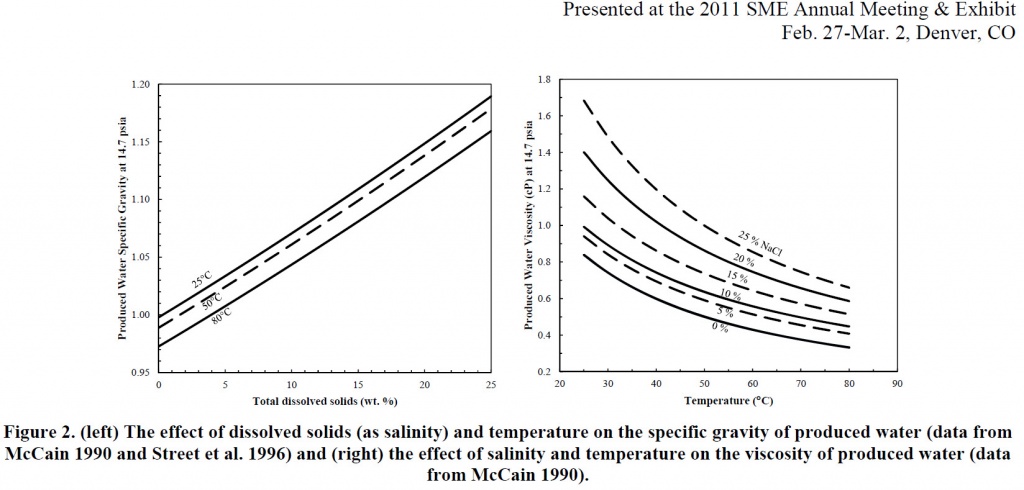Liquid Desander –Correction for Density and Viscosity (B-FSM058)

The correction for solid:fluid density and fluid viscosity follow similar approach as that for solids concentration and pressure drop as previous posted (see post B-FSM-057).

C3 – Solid:Fluid Density (using specific gravity)
Correction factor C3 is applied for the solid:fluid density differential. The base conditions are sand at 2.65 s.g. in water at 1.0 s.g. (see post B-FSM-055). At these conditions C3=1.0. as the density differential increases it becomes easier to separate the solids from the liquid. Either making the solids heavier or making the liquid less dense achieve the same effect. Most oilfield solids range from 2.5-2.8 specific gravity (see post B-FSM-008 from 12-Sep-17). Produced water ranges from 0.7-1.2 s.g. normally based on the amount of dissolved solids and the process temperature. Increasing the total dissolved solids (TDS) increases fluid density, while increasing process temperature lowers fluid density. For example, alumina-based proppant (2.85 s.g.) in produced water with 10% TDS at 50°C (1.06 s.g.) would yield a value of C3 = 0.96.
C4 – Fluid Viscosity
Fluid viscosity has a very significant affect on desander performance, and is accounted for by correction factor C4. The guideline is that the continuous phase fluid viscosity correction factor is the square root of the viscosity based in cP. Thus at 1.0 cP, C4 = 1.0 and at 10 cP, C4 = 3.16. This can have a dramatic effect on desander separation efficiency, thus it always best to put the desander on the lowest viscosity fluid. Typically this is at the hottest location. As produced water leaves the production separator or FWKO it will drop in temperature, so all hydrocyclone technologies (desanders and deoilers) should be put directly on the outlet line where the viscosity is lowest.
Values for produced water density and viscosity can be obtained from McCain (Ref. 3). I have also listed several graphs below that should be of help. These are from my oil droplet flotation publication (Ref. 4). Both amount of dissolved solids and temperature change produced water density and viscosity per the relationships presented.

Continuing with our previous example of a 10” insert desander (with D50base = 22 microns), at dilute concentration (C1=1.0) and 25 psi pressure drop operation (C2 = 0.78), we will assume it is operating on silica sand (2.65 s.g.) in produced water at 50°C and 15% TDS (C3 = 1.03 and C4 = 0.88). The D50req. is now at 15.6 microns. Both pressure drop and viscosity have lowered the separation size and improved solids recovery.
The next article will work out a more detailed example for desander sizing.
References
- McCain, W.D. Jr. 1990. The Properties of Petroleum Fluids 2nd Edition, PennWell Publishing Company, Tulsa, OK, 1990.
- Plitt, L.R. 1976. “A Mathematical Model of the Hydrocyclone Classifier”, CIM Bulletin, December, pp. 115-123.
- Rawlins, C.H., and Wang, I. I. 2001. “Design and Installation of a Sand Separation and Handling System for a Gulf of Mexico Oil Production Facility,” SPE Production and Facilities, paper 72999, Vol. 16, No. 3, pp. 134-140.
- Rawlins, C.H. 2011. “Mechanisms for Flotation of Fine Oil Droplets”, presented at the 2011 SME Annual Meeting & Exhibit, Denver, CO, Feb. 27-Mar. 2.
- Svarovsky, L. 1984. Hydrocyclones, Technomics Publishing Co. Inc., Lancaster, PA.
